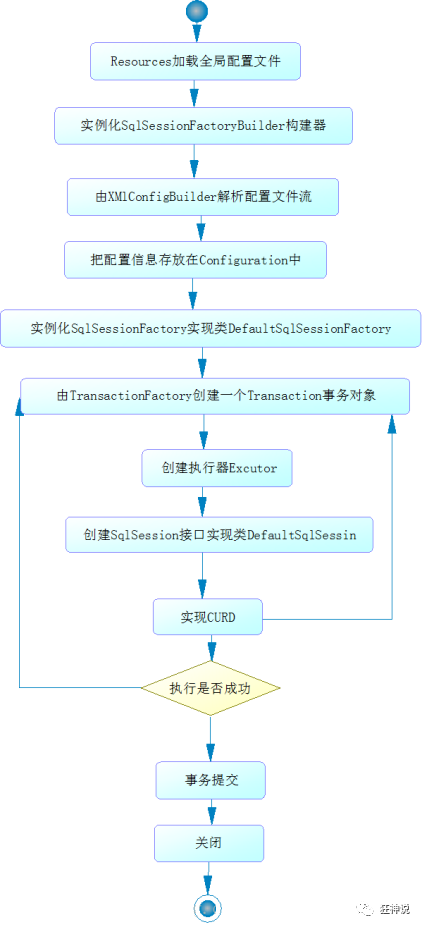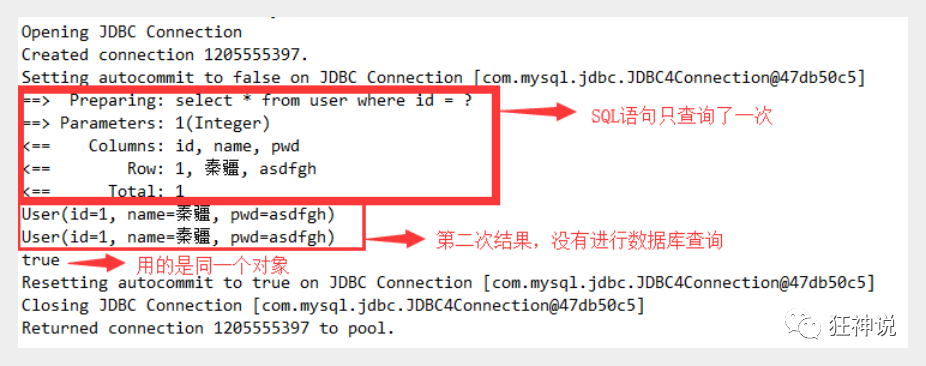Mybatis
是一款优秀的持久层框架
它支持自定义 SQL、存储过程以及高级映射。
MyBatis 免除了几乎所有的 JDBC 代码以及设置参数和获取结果集的工作。
MyBatis 可以通过简单的 XML 或注解来配置和映射原始类型、接口和 Java POJO(Plain Old Java Objects,普通老式 Java 对象)为数据库中的记录。
入门

作用域理解
SqlSessionFactoryBuilder
作用在于创建 SqlSessionFactory,创建成功后,SqlSessionFactoryBuilder 就失去了作用,所以它只能存在于创建 SqlSessionFactory 的方法中,而不要让其长期存在。因此 SqlSessionFactoryBuilder 实例的最佳作用域是方法作用域(也就是局部方法变量)。
SqlSessionFactory
可以被认为是一个数据库连接池,它的作用是创建 SqlSession 接口对象。SqlSessionFactory 一旦被创建就应该在应用的运行期间一直存在,没有任何理由丢弃它或重新创建另一个实例。 使用 SqlSessionFactory 的最佳实践是在应用运行期间不要重复创建多次,多次重建 SqlSessionFactory 被视为一种代码“坏习惯”。因此 SqlSessionFactory 的最佳作用域是应用作用域。有很多方法可以做到,最简单的就是使用单例模式或者静态单例模式。
SqlSession
如果说 SqlSessionFactory 相当于数据库连接池,那么 SqlSession 就相当于一个数据库连接(Connection 对象),你可以在一个事务里面执行多条 SQL,然后通过它的 commit、rollback 等方法,提交或者回滚事务。所以它应该存活在一个业务请求中,处理完整个请求后,应该关闭这条连接,让它归还给 SqlSessionFactory,否则数据库资源就很快被耗费精光,系统就会瘫痪,所以用 try…catch…finally… 语句来保证其正确关闭。所以 SqlSession 的最佳的作用域是请求或方法作用域。

第一个Mybatis程序
步骤

思路流程:搭建环境–>导入Mybatis—>编写代码—>测试
1、搭建实验数据库
2、导入MyBatis相关 jar 包
<!-- https://mvnrepository.com/artifact/org.mybatis/mybatis -->
<dependency>
<groupId>org.mybatis</groupId>
<artifactId>mybatis</artifactId>
<version>3.5.7</version>
</dependency>
3、编写MyBatis核心配置文件
- 每个基于 MyBatis 的应用都是以一个
SqlSessionFactory的实例为核心的。SqlSessionFactory 的实例可以通过SqlSessionFactoryBuilder获得。而 SqlSessionFactoryBuilder 则可以从 XML 配置文件或一个预先配置的 Configuration 实例来构建出 SqlSessionFactory 实例。 mybatis-config.xml
<?xml version="1.0" encoding="UTF-8" ?>
<!DOCTYPE configuration
PUBLIC "-//mybatis.org//DTD Config 3.0//EN"
"http://mybatis.org/dtd/mybatis-3-config.dtd">
<!--configuration核心配置文件-->
<configuration>
<environments default="development">
<environment id="development">
<transactionManager type="JDBC"/>
<dataSource type="POOLED">
<!--属性配置-->
<property name="driver" value="com.mysql.cj.jdbc.Driver"/>
<property name="url" value="jdbc:mysql://localhost:3306/mybatis?useSSL=true&userUnicode=true&characterEncoding=UTF-8&serverTimezone=UTC "/>
<property name="username" value="root"/>
<property name="password" value="123456"/>
</dataSource>
</environment>
</environments>
<!--每一个Mapper.xml都需要在Mybatis核心配置文件中注册-->
<mappers>
<mapper resource="com/huang/dao/UserMapper.xml"/>
</mappers>
</configuration>
4、编写MyBatis工具类
-
既然有了 SqlSessionFactory,顾名思义,我们可以从中获得
SqlSession 的实例。 -
SqlSession 提供了在数据库执行 SQL 命令所需的所有方法。
-
MybatisUtils.java
//sqlSessionFactory --> sqlSession
public class MybatisUtils {
private static SqlSessionFactory sqlSessionFactory;
static {
try {
//1、获取sqlSessionFactory对象
String resource = "mybatis-config.xml";
InputStream inputStream = Resources.getResourceAsStream(resource);
sqlSessionFactory = new SqlSessionFactoryBuilder().build(inputStream);
} catch (IOException e) {
e.printStackTrace();
}
}
//2、获取SqlSession连接
public static SqlSession getSqlSession(){
return sqlSessionFactory.openSession();
}
}
5、创建实体类
6、编写Mapper接口类 (相当于Dao接口)
public interface UserMapper {
List<User> selectUser();
}
7、编写Mapper.xml配置文件(相当于接口实现类DaoImpl)
- namespace 十分重要,不能写错!
<?xml version="1.0" encoding="UTF-8" ?>
<!DOCTYPE mapper
PUBLIC "-//mybatis.org//DTD Mapper 3.0//EN"
"http://mybatis.org/dtd/mybatis-3-mapper.dtd">
<!--namespace 绑定一个对应的Dao/Mapper接口-->
<mapper namespace="com.huang.dao.UserMapper">
<!--select查询语句
id:方法名
resultType:返回类型
parameterType:参数类型-->
<select id="getUserList" resultType="com.huang.pojo.User">
select * from user
</select>
<select id="getUserById" resultType="com.huang.pojo.User" parameterType="int">
select * from user where id = #{id}
</select>
</mapper>
8、编写测试类
- Junit 包测试
public class UserDaoTest {
@Test
public void test(){
//1、获得SqlSession对象
SqlSession sqlSession = MybatisUtils.getSqlSession();
//2、执行SQL
//方式一:getMapper
UserMapper userMapper = sqlSession.getMapper(UserMapper.class);
List<User> userList = userMapper.getUserList();
//方式二: 不推荐
//List<User> userList = sqlSession.selectList("com.huang.dao.UserMapper.getUserList");
for(User user:userList){
System.out.println(user);
}
//3、关闭SqlSession
sqlSession.close();
}
}
错误点
-
错误:org.apache.ibatis.binding.BindingException: Type interface com.huang.dao.UserMapper is not known to the MapperRegistry.
解决:每一个Mapper.xml都需要在Mybatis核心配置文件中注册,
mybatis-config.xml<!--每一个Mapper.xml都需要在Mybatis核心配置文件中注册--> <mappers> <mapper resource="com/huang/dao/UserMapper.xml"/> </mappers> -
错误:java.lang.ExceptionInInitializerError
-
解决:Maven静态资源过滤问题(经常遇到)
<!--在build中配置resources,来防止我们资源导出失败的问题--> <build> <resources> <resource> <directory>src/main/resources</directory> <includes> <include>**/*.properties</include> <include>**/*.xml</include> </includes> <filtering>true</filtering> </resource> <resource> <directory>src/main/java</directory> <includes> <include>**/*.properties</include> <include>**/*.xml</include> </includes> <filtering>true</filtering> </resource> </resources> </build>
-
-
错误:org.apache.ibatis.exceptions.PersistenceException
解决:异常的原因是因为pom.xml引入的mysql版本和系统安装的mysql版本时序是不一样的
只需要在写url的时候,在最后面加上 serverTimezone=UTC 可以可以了.
配置解析
-
mybatis-config.xml -
configuration(配置) properties(属性) settings(设置) typeAliases(类型别名) typeHandlers(类型处理器) objectFactory(对象工厂) plugins(插件) environments(环境配置) environment(环境变量) transactionManager(事务管理器) dataSource(数据源) databaseIdProvider(数据库厂商标识) mappers(映射器)
1、环境配置(environments)
MyBatis 可以配置成适应多种环境,尽管可以配置多个环境,但每个 SqlSessionFactory 实例只能选择一种环境。
<environments default="development">
<environment id="development">
<transactionManager type="JDBC">
<property name="..." value="..."/>
</transactionManager>
<dataSource type="POOLED">
<property name="driver" value="${driver}"/>
<property name="url" value="${url}"/>
<property name="username" value="${username}"/>
<property name="password" value="${password}"/>
</dataSource>
</environment>
</environments>
-
配置MyBatis的多套运行环境,将SQL映射到多个不同的数据库上,必须指定其中一个为默认运行环境(通过default指定)
-
子元素节点:environment
-
-
dataSource 元素使用标准的 JDBC 数据源接口来配置 JDBC 连接对象的资源。
-
数据源是必须配置的。
-
有三种内建的数据源类型
type="[UNPOOLED|POOLED|JNDI]") -
unpooled:这个数据源的实现只是每次被请求时打开和关闭连接。
-
pooled:这种数据源的实现利用“池”的概念将 JDBC 连接对象组织起来 , 这是一种使得并发 Web 应用快速响应请求的流行处理方式。
-
jndi:这个数据源的实现是为了能在如 Spring 或应用服务器这类容器中使用,容器可以集中或在外部配置数据源,然后放置一个 JNDI 上下文的引用。
-
数据源也有很多第三方的实现,比如dbcp,c3p0,druid等等…
-
这两种事务管理器类型都不需要设置任何属性。
-
具体的一套环境,通过设置id进行区别,id保证唯一!
-
子元素节点:transactionManager - [ 事务管理器 ]
<!-- 语法 --> <transactionManager type="[ JDBC | MANAGED ]"/> -
子元素节点:数据源(dataSource)
-
2、属性(properties)
实现引用配置文件。数据库这些属性都是可外部配置且可动态替换的,既可以在典型的 Java 属性文件[db.properties]中配置,亦可通过 properties 元素的子元素来传递。
我们来优化我们的配置文件
第一步 :在资源目录下新建一个db.properties
driver=com.mysql.cj.jdbc.Driver
url=jdbc:mysql://localhost:3306/mybatis?useSSL=true&userUnicode=true&characterEncoding=UTF-8&serverTimezone=UTC
username=root
password=123456
第二步 : 将文件导入properties 配置文件
<?xml version="1.0" encoding="UTF-8" ?>
<!DOCTYPE configuration
PUBLIC "-//mybatis.org//DTD Config 3.0//EN"
"http://mybatis.org/dtd/mybatis-3-config.dtd">
<!--configuration核心配置文件-->
<configuration>
<!--引入外部配置文件-->
<properties resource="db.properties"/>
<environments default="development">
<environment id="development">
<transactionManager type="JDBC"/>
<dataSource type="POOLED">
<!--属性配置-->
<property name="driver" value="${driver}"/>
<property name="url" value="${url}"/>
<property name="username" value="${username}"/>
<property name="password" value="${password}"/>
</dataSource>
</environment>
</environments>
<!--每一个Mapper.xml都需要在Mybatis核心配置文件中注册-->
<mappers>
<mapper resource="com/huang/dao/UserMapper.xml"/>
</mappers>
</configuration>
- 配置文件优先级问题,优先使用外部文件
3、类型别名(typeAliases)
类型别名可为 Java 类型设置一个缩写名字。 它仅用于 XML 配置,意在降低冗余的全限定类名书写。
也可以指定一个包名,MyBatis 会在包名下面搜索需要的 Java Bean。每一个在包 com.huang.pojo 中的 Java Bean,在没有注解的情况下,会使用 Bean 的首字母小写的非限定类名来作为它的别名。 比如 com.huang.pojo。User 的别名为 user。
<typeAliases>
<typeAlias type="com.huang.pojo.User" alias="User"/>
<package name="com.huang.pojo"/>
</typeAliases>
若有注解,则别名为其注解值。见下面的例子:
@Alias("user")
public class User {
...
}
4、设置(settings)
这是 MyBatis 中极为重要的调整设置,它们会改变 MyBatis 的运行时行为。
一个配置完整的 settings 元素的示例如下:
<settings>
<setting name="cacheEnabled" value="true"/>
<setting name="lazyLoadingEnabled" value="true"/>
<setting name="multipleResultSetsEnabled" value="true"/>
<setting name="useColumnLabel" value="true"/>
<setting name="useGeneratedKeys" value="false"/>
<setting name="autoMappingBehavior" value="PARTIAL"/>
<setting name="autoMappingUnknownColumnBehavior" value="WARNING"/>
<setting name="defaultExecutorType" value="SIMPLE"/>
<setting name="defaultStatementTimeout" value="25"/>
<setting name="defaultFetchSize" value="100"/>
<setting name="safeRowBoundsEnabled" value="false"/>
<setting name="mapUnderscoreToCamelCase" value="false"/>
<setting name="localCacheScope" value="SESSION"/>
<setting name="jdbcTypeForNull" value="OTHER"/>
<setting name="lazyLoadTriggerMethods" value="equals,clone,hashCode,toString"/>
</settings>
映射器
mappers
这些配置会告诉 MyBatis 去哪里找映射文件
<!-- 使用相对于类路径的资源引用 -->
<mappers>
<mapper resource="org/mybatis/builder/AuthorMapper.xml"/>
</mappers>
<!-- 使用映射器接口实现类的完全限定类名
需要配置文件名称和接口名称一致,并且位于同一目录下
推荐使用-->
<mappers>
<mapper class="org.mybatis.builder.AuthorMapper"/>
</mappers>
<!-- 将包内的映射器接口实现全部注册为映射器
但是需要配置文件名称和接口名称一致,并且位于同一目录下-->
<mappers>
<package name="org.mybatis.builder"/>
</mappers>
Mapper文件
<?xml version="1.0" encoding="UTF-8" ?>
<!DOCTYPE mapper
PUBLIC "-//mybatis.org//DTD Mapper 3.0//EN"
"http://mybatis.org/dtd/mybatis-3-mapper.dtd">
<mapper namespace="com.kuang.mapper.UserMapper">
</mapper>
-
namespace中文意思:命名空间,作用如下:
-
- namespace的命名必须跟某个接口同名
- 接口中的方法与映射文件中sql语句id应该一一对应
-
- namespace和子元素的id联合保证唯一 , 区别不同的mapper
- 绑定DAO接口
- namespace命名规则 : 包名+类名
MyBatis 的真正强大在于它的映射语句,这是它的魔力所在。由于它的异常强大,映射器的 XML 文件就显得相对简单。如果拿它跟具有相同功能的 JDBC 代码进行对比,你会立即发现省掉了将近 95% 的代码。MyBatis 为聚焦于 SQL 而构建,以尽可能地为你减少麻烦。
CRUD增删改查
注意:增删改需要提交事务
<!--User实体类对象中的属性可以直接取出来 需要一一对应-->
<insert id="addUser" parameterType="com.huang.pojo.User">
insert into user (id,name,pwd) value (#{id},#{name },#{pwd});
</insert>
<!--修改-->
<update id="updateUser" parameterType="com.huang.pojo.User">
update user set name = #{name},pwd=#{pwd} where id=#{id};
</update>
<!--删除-->
<delete id="deleteUser" parameterType="int">
delete from user where id = #{id};
</delete>
//增删改需要提交事务
int res = userMapper.addUser(new User(4,"哈哈","12323"));
if(res > 0) System.out.println("插入成功");
sqlSession.commit(); //提交事务
**技巧:**参数用map #{key }即可 parameterType="map"
模糊查询:
-
Java代码执行的时候,传递通配符% %
List<User> userList = userMapper.getUserLike("%李%"); -
在sql拼接中使用通配符
<!--考虑sql注入问题--> <select id="getUserLike" resultType="com.huang.pojo.User"> select * from user where name like "%"#{value}"%" </select>
ResultMap
resultMap 元素是 MyBatis 中最重要最强大的元素。它可以让你从 90% 的 JDBC ResultSets 数据提取代码中解放出来,并在一些情形下允许你进行一些 JDBC 不支持的操作.
ResultMap 的设计思想是,对于简单的语句根本不需要配置显式的结果映射,而对于复杂一点的语句只需要描述它们的关系就行了。
<resultMap id="UserMap" type="User">
<!-- id为主键 -->
<id column="id" property="id"/>
<!-- column是数据库表的列名 , property是对应实体类的属性名 -->
<result column="name" property="name"/>
<result column="pwd" property="password"/>
</resultMap>
<select id="selectUserById" resultMap="UserMap">
select id , name , pwd from user where id = #{id}
</select>
自动映射
你已经见过简单映射语句的示例了,但并没有显式指定 resultMap。比如:
<select id="selectUserById" resultType="map">
select id , name , pwd
from user
where id = #{id}
</select>
上述语句只是简单地将所有的列映射到 HashMap 的键上,这由 resultType 属性指定。虽然在大部分情况下都够用,但是 HashMap 不是一个很好的模型。你的程序更可能会使用 JavaBean 或 POJO(Plain Old Java Objects,普通老式 Java 对象)作为模型。
日志
Mybatis内置的日志工厂提供日志功能,具体的日志实现有以下几种工具:
- SLF4J
- Apache Commons Logging
- Log4j 2
- Log4j
- JDK logging
具体选择哪个日志实现工具由MyBatis的内置日志工厂确定。它会使用最先找到的(按上文列举的顺序查找)。如果一个都未找到,日志功能就会被禁用。
标准日志实现
指定 MyBatis 应该使用哪个日志记录实现。如果此设置不存在,则会自动发现日志记录实现。

<settings>
<setting name="logImpl" value="STDOUT_LOGGING"/><!--标准日志工厂-->
</settings>
测试,可以看到控制台有大量的输出!我们可以通过这些输出来判断程序到底哪里出了Bug
Log4j
简介:
- Log4j是Apache的一个开源项目
- 通过使用Log4j,我们可以控制日志信息输送的目的地:控制台,文本,GUI组件…
- 我们也可以控制每一条日志的输出格式;
- 通过定义每一条日志信息的级别,我们能够更加细致地控制日志的生成过程。最令人感兴趣的就是,这些可以通过一个配置文件来灵活地进行配置,而不需要修改应用的代码。
使用步骤:
1、导入log4j的包
<dependency>
<groupId>log4j</groupId>
<artifactId>log4j</artifactId>
<version>1.2.17</version>
</dependency>
2、配置文件编写log4j.properties
#将等级为DEBUG的日志信息输出到console和file这两个目的地,console和file的定义在下面的代码
log4j.rootLogger=DEBUG,console,file
#控制台输出的相关设置
log4j.appender.console = org.apache.log4j.ConsoleAppender
log4j.appender.console.Target = System.out
log4j.appender.console.Threshold=DEBUG
log4j.appender.console.layout = org.apache.log4j.PatternLayout
log4j.appender.console.layout.ConversionPattern=[%c]-%m%n
#文件输出的相关设置
log4j.appender.file = org.apache.log4j.RollingFileAppender
log4j.appender.file.File=./log/huang.log
log4j.appender.file.MaxFileSize=10mb
log4j.appender.file.Threshold=DEBUG
log4j.appender.file.layout=org.apache.log4j.PatternLayout
log4j.appender.file.layout.ConversionPattern=[%p][%d{yy-MM-dd}][%c]%m%n
#日志输出级别
log4j.logger.org.mybatis=DEBUG
log4j.logger.java.sql=DEBUG
log4j.logger.java.sql.Statement=DEBUG
log4j.logger.java.sql.ResultSet=DEBUG
log4j.logger.java.sql.PreparedStatement=DEBUG
3、setting设置日志实现
<settings>
<setting name="logImpl" value="LOG4J"/>
</settings>
4、在程序中使用Log4j进行输出!
//注意导包:org.apache.log4j.Logger
static Logger logger = Logger.getLogger(MyTest.class);
@Test
public void selectUser() {
logger.info("info:进入selectUser方法");
logger.debug("debug:进入selectUser方法");
logger.error("error: 进入selectUser方法");
SqlSession session = MybatisUtils.getSession();
UserMapper mapper = session.getMapper(UserMapper.class);
List<User> users = mapper.selectUser();
for (User user: users){
System.out.println(user);
}
session.close();
}
5、测试,看控制台输出!
- 使用Log4j 输出日志
- 可以看到还生成了一个日志的文件 【需要修改file的日志级别】
分页
limit实现分页
语法
SELECT * FROM table LIMIT stratIndex,pageSize
SELECT * FROM table LIMIT 5,10; // 检索记录行 6-15
#为了检索从某一个偏移量到记录集的结束所有的记录行,可以指定第二个参数为 -1:
SELECT * FROM table LIMIT 95,-1; // 检索记录行 96-last.
#如果只给定一个参数,它表示返回最大的记录行数目:
SELECT * FROM table LIMIT 5; //检索前 5 个记录行
#换句话说,LIMIT n 等价于 LIMIT 0,n。
步骤:
1、修改Mapper文件
<select id="selectUser" parameterType="map" resultType="user">
select * from user limit #{startIndex},#{pageSize}
</select>
2、Mapper接口,参数为map
//选择全部用户实现分页
List<User> selectUser(Map<String,Integer> map);
3、在测试类中传入参数测试
- 推断:起始位置 = (当前页面 - 1 ) * 页面大小
//分页查询 , 两个参数startIndex , pageSize
@Test
public void testSelectUser() {
SqlSession session = MybatisUtils.getSession();
UserMapper mapper = session.getMapper(UserMapper.class);
int currentPage = 1; //第几页
int pageSize = 2; //每页显示几个
Map<String,Integer> map = new HashMap<String,Integer>();
map.put("startIndex",(currentPage-1)*pageSize);
map.put("pageSize",pageSize);
List<User> users = mapper.selectUser(map);
for (User user: users){
System.out.println(user);
}
session.close();
}
RowBounds分页
我们除了使用Limit在SQL层面实现分页,也可以使用RowBounds在Java代码层面实现分页,当然此种方式作为了解即可。我们来看下如何实现的!
步骤:
1、mapper接口
2、mapper文件
3、测试类
在这里,我们需要使用RowBounds类
@Test
public void testUserByRowBounds() {
SqlSession session = MybatisUtils.getSession();
int currentPage = 2; //第几页
int pageSize = 2; //每页显示几个
RowBounds rowBounds = new RowBounds((currentPage-1)*pageSize,pageSize);
//通过session.**方法进行传递rowBounds,[此种方式现在已经不推荐使用了]
List<User> users = session.selectList("com.kuang.mapper.UserMapper.getUserByRowBounds", null, rowBounds);
for (User user: users){
System.out.println(user);
}
session.close();
}
PageHelper分页插件
了解即可,可以自己尝试使用
官方文档:https://pagehelper.github.io/
使用注解开发
本质:反射机制实现
底层:动态代理
public interface UserMapper {
@Select("select * from user")
List<User> getUser();
}
<!--绑定接口-->
<mappers>
<mapper class="com.huang.dao.UserMapper"/>
</mappers>
自动提交事务
//获取SqlSession连接
public static SqlSession getSession(){
return getSession(true); //事务自动提交
}
public static SqlSession getSession(boolean flag){
return sqlSessionFactory.openSession(flag);
}
【注意】确保实体类和数据库字段对应
@Param
//根据id查询用户
@Select("select * from user where id = #{id}")
User selectUserById(@Param("id") int id);
@Param注解用于给方法参数起一个名字。以下是总结的使用原则:
- 在方法只接受一个参数的情况下,可以不使用@Param。
- 在方法接受多个参数的情况下,建议一定要使用@Param注解给参数命名。
- 如果参数是 JavaBean , 则不能使用@Param。
- 不使用@Param注解时,参数只能有一个,并且是Javabean。
Mybatis执行流程

嵌套查询
多对一(association)
按查询嵌套处理——子查询
编写对应的Mapper文件
<?xml version="1.0" encoding="UTF-8" ?>
<!DOCTYPE mapper
PUBLIC "-//mybatis.org//DTD Mapper 3.0//EN"
"http://mybatis.org/dtd/mybatis-3-mapper.dtd">
<mapper namespace="com.kuang.mapper.StudentMapper">
<!--
需求:获取所有学生及对应老师的信息
思路:
1. 获取所有学生的信息
2. 根据获取的学生信息的老师ID->获取该老师的信息
3. 思考问题,这样学生的结果集中应该包含老师,该如何处理呢,数据库中我们一般使用关联查询?
1. 做一个结果集映射:StudentTeacher
2. StudentTeacher结果集的类型为 Student
3. 学生中老师的属性为teacher,对应数据库中为tid。
多个 [1,...)学生关联一个老师=> 一对一,一对多
4. 查看官网找到:association – 一个复杂类型的关联;使用它来处理关联查询
-->
<select id="getStudents" resultMap="StudentTeacher">
select * from student
</select>
<resultMap id="StudentTeacher" type="Student">
<!--association关联属性 property属性名 javaType属性类型 column在多的一方的表中的列名-->
<association property="teacher" column="tid" javaType="Teacher" select="getTeacher"/>
</resultMap>
<!--
这里传递过来的id,只有一个属性的时候,下面可以写任何值
association中column多参数配置:
column="{key=value,key=value}"
其实就是键值对的形式,key是传给下个sql的取值名称,value是片段一中sql查询的字段名。
-->
<select id="getTeacher" resultType="teacher">
select * from teacher where id = #{id}
</select>
</mapper>
注意点说明:
<resultMap id="StudentTeacher" type="Student">
<!--association关联属性 property属性名 javaType属性类型 column在多的一方的表中的列名-->
<association property="teacher" column="{id=tid,name=tid}" javaType="Teacher" select="getTeacher"/>
</resultMap>
<!--
这里传递过来的id,只有一个属性的时候,下面可以写任何值
association中column多参数配置:
column="{key=value,key=value}"
其实就是键值对的形式,key是传给下个sql的取值名称,value是片段一中sql查询的字段名。
-->
<select id="getTeacher" resultType="teacher">
select * from teacher where id = #{id} and name = #{name}
</select>
按结果嵌套处理——联表查询
写对应的mapper文件
<!--
按查询结果嵌套处理
思路:
1. 直接查询出结果,进行结果集的映射
-->
<select id="getStudents2" resultMap="StudentTeacher2" >
select s.id sid, s.name sname , t.name tname
from student s,teacher t
where s.tid = t.id
</select>
<resultMap id="StudentTeacher2" type="Student">
<id property="id" column="sid"/>
<result property="name" column="sname"/>
<!--关联对象property 关联对象在Student实体类中的属性-->
<association property="teacher" javaType="Teacher">
<result property="name" column="tname"/>
</association>
</resultMap>
一对多(collection)
按结果嵌套处理——联表查询
编写接口对应的Mapper配置文件
<mapper namespace="com.kuang.mapper.TeacherMapper">
<!--
思路:
1. 从学生表和老师表中查出学生id,学生姓名,老师姓名
2. 对查询出来的操作做结果集映射
1. 集合的话,使用collection!
JavaType和ofType都是用来指定对象类型的
JavaType是用来指定pojo中属性的类型
ofType指定的是映射到list集合属性中pojo的类型。
-->
<select id="getTeacher" resultMap="TeacherStudent">
select s.id sid, s.name sname , t.name tname, t.id tid
from student s,teacher t
where s.tid = t.id and t.id=#{id}
</select>
<resultMap id="TeacherStudent" type="Teacher">
<result property="name" column="tname"/>
<collection property="students" ofType="Student">
<result property="id" column="sid" />
<result property="name" column="sname" />
<result property="tid" column="tid" />
</collection>
</resultMap>
</mapper>
按查询嵌套处理——子查询
编写接口对应的Mapper配置文件
<select id="getTeacher2" resultMap="TeacherStudent2">
select * from teacher where id = #{id}
</select>
<resultMap id="TeacherStudent2" type="Teacher">
<!--column是一对多的外键 , 写的是一的主键的列名-->
<collection property="students" javaType="ArrayList" ofType="Student" column="id" select="getStudentByTeacherId"/>
</resultMap>
<select id="getStudentByTeacherId" resultType="Student">
select * from student where tid = #{id}
</select>
小结
1、关联-association
2、集合-collection
3、所以association是用于一对一和多对一,而collection是用于一对多的关系
4、JavaType和ofType都是用来指定对象类型的
- JavaType是用来指定pojo中属性的类型
- ofType指定的是映射到list集合属性中pojo的类型。
注意说明:
1、保证SQL的可读性,尽量通俗易懂
2、根据实际要求,尽量编写性能更高的SQL语句
3、注意属性名和字段不一致的问题
4、注意一对多和多对一 中:字段和属性对应的问题
5、尽量使用Log4j,通过日志来查看自己的错误
动态SQL
动态SQL指的是根据不同的查询条件 , 生成不同的Sql语句.
IDutil工具类
public class IDUtil {
public static String genId(){
return UUID.randomUUID().toString().replaceAll("-","");
}
}
if
需求:根据作者名字和博客名字来查询博客!如果作者名字为空,那么只根据博客名字查询,反之,则根据作者名来查询
<!--需求1:
根据作者名字和博客名字来查询博客!
如果作者名字为空,那么只根据博客名字查询,反之,则根据作者名来查询
select * from blog where title = #{title} and author = #{author}
-->
<select id="queryBlogIf" parameterType="map" resultType="blog">
select * from blog where
<if test="title != null">
title = #{title}
</if>
<if test="author != null">
and author = #{author}
</if>
</select>
这样写我们可以看到,如果 author 等于 null,那么查询语句为 select * from user where title=#{title},但是如果title为空呢?那么查询语句为 select * from user where and author=#{author},这是错误的 SQL 语句,如何解决呢?请看下面的 where 语句!
Where
修改上面的SQL语句;
<select id="queryBlogIf" parameterType="map" resultType="blog">
select * from blog
<where>
<if test="title != null">
title = #{title}
</if>
<if test="author != null">
and author = #{author}
</if>
</where>
</select>
这个“where”标签会知道如果它包含的标签中有返回值的话,它就插入一个‘where’。此外,如果标签返回的内容是以AND 或OR 开头的,则它会剔除掉。
Set
同理,上面的对于查询 SQL 语句包含 where 关键字,如果在进行更新操作的时候,含有 set 关键词.
set 元素会动态地在行首插入 SET 关键字,并会删掉额外的逗号(这些逗号是在使用条件语句给列赋值时引入的)。
<!--注意set是用的逗号隔开-->
<update id="updateBlog" parameterType="map">
update blog
<set>
<if test="title != null">
title = #{title},
</if>
<if test="author != null">
author = #{author}
</if>
</set>
where id = #{id};
</update>
choose
我们不想用到所有的查询条件,只想选择其中的一个,查询条件有一个满足即可,使用 choose 标签可以解决此类问题,类似于 Java 的 switch 语句
<select id="queryBlogChoose" parameterType="map" resultType="blog">
select * from blog
<where>
<choose>
<when test="title != null">
title = #{title}
</when>
<when test="author != null">
and author = #{author}
</when>
<otherwise>
and views = #{views}
</otherwise>
</choose>
</where>
</select>
SQL片段
抽取公共的sql代码
提取SQL片段:
<sql id="if-title-author">
<if test="title != null">
title = #{title}
</if>
<if test="author != null">
and author = #{author}
</if>
</sql>
引用SQL片段:
<select id="queryBlogIf" parameterType="map" resultType="blog">
select * from blog
<where>
<!-- 引用 sql 片段,如果refid 指定的不在本文件中,那么需要在前面加上 namespace -->
<include refid="if-title-author"></include>
<!-- 在这里还可以引用其他的 sql 片段 -->
</where>
</select>
注意:
①、最好基于 单表来定义 sql 片段,提高片段的可重用性
②、在 sql 片段中不要包括 where
Foreach
将数据库中前三个数据的id修改为1,2,3;
需求:我们需要查询 blog 表中 id 分别为1,2,3的博客信息
<select id="queryBlogForeach" parameterType="map" resultType="blog">
select * from blog
<where>
<!--
collection:指定输入对象中的集合属性
item:每次遍历生成的对象
open:开始遍历时的拼接字符串
close:结束时拼接的字符串
separator:遍历对象之间需要拼接的字符串
select * from blog where 1=1 and (id=1 or id=2 or id=3)
-->
<foreach collection="ids" item="id" open="and (" close=")" separator="or">
id=#{id}
</foreach>
</where>
</select>
缓存
-
MyBatis系统中默认定义了两级缓存:一级缓存和二级缓存
-
- 默认情况下,只有一级缓存开启。(SqlSession级别的缓存,也称为本地缓存)
- 二级缓存需要手动开启和配置,他是基于namespace级别的缓存。
- 为了提高扩展性,MyBatis定义了缓存接口Cache。我们可以通过实现Cache接口来自定义二级缓存
一级缓存
一级缓存也叫本地缓存,类似一个map。
- 与数据库同一次会话期间查询到的数据会放在本地缓存中。
- 以后如果需要获取相同的数据,直接从缓存中拿,没必须再去查询数据库;

一级缓存失效的四种情况
一级缓存是SqlSession级别的缓存,是一直开启的,我们关闭不了它;
一级缓存失效情况:没有使用到当前的一级缓存,效果就是,还需要再向数据库中发起一次查询请求!
- sqlSession不同。每个sqlSession中的缓存相互独立
- sqlSession相同,查询条件不同。当前缓存中,不存在这个数据
- sqlSession相同,两次查询之间执行了增删改操作!为增删改操作可能会对当前数据产生影响
- sqlSession相同,手动清除一级缓存
session.clearCache();//手动清除缓存
二级缓存
-
二级缓存也叫全局缓存,一级缓存作用域太低了,所以诞生了二级缓存
-
基于namespace级别的缓存,一个名称空间,对应一个二级缓存;
-
工作机制
-
- 一个会话查询一条数据,这个数据就会被放在当前会话的一级缓存中;
- 如果当前会话关闭了,这个会话对应的一级缓存就没了;但是我们想要的是,会话关闭了,一级缓存中的数据被保存到二级缓存中;
- 新的会话查询信息,就可以从二级缓存中获取内容;
- 不同的mapper查出的数据会放在自己对应的缓存(map)中;
-
使用步骤
-
1、开启全局缓存 【mybatis-config.xml】
-
<setting name="cacheEnabled" value="true"/> -
2、去每个mapper.xml中配置使用二级缓存,这个配置非常简单;【xxxMapper.xml】
-
<cache/> 官方示例=====>查看官方文档 <cache eviction="FIFO" flushInterval="60000" size="512" readOnly="true"/> 这个更高级的配置创建了一个 FIFO 缓存,每隔 60 秒刷新,最多可以存储结果对象或列表的 512 个引用,而且返回的对象被认为是只读的,因此对它们进行修改可能会在不同线程中的调用者产生冲突。
注意:所有的实体类先实现序列化接口
结论
- 只要开启了二级缓存,我们在同一个Mapper中的查询,可以在二级缓存中拿到数据
- 查出的数据都会被默认先放在一级缓存中
- 只有会话提交或者关闭以后,一级缓存中的数据才会转到二级缓存中
缓存原理图
先二级缓存,找不到则一级缓存,否则找数据库并保存到一级缓存。

EhCache
Ehcache是一种广泛使用的java分布式缓存,用于通用缓存;
要在应用程序中使用Ehcache,需要引入依赖的jar包
<!-- https://mvnrepository.com/artifact/org.mybatis.caches/mybatis-ehcache -->
<dependency>
<groupId>org.mybatis.caches</groupId>
<artifactId>mybatis-ehcache</artifactId>
<version>1.1.0</version>
</dependency>
在mapper.xml中使用对应的缓存即可
<mapper namespace = “org.acme.FooMapper” >
<cache type = “org.mybatis.caches.ehcache.EhcacheCache” />
</mapper>
编写ehcache.xml文件,如果在加载时未找到/ehcache.xml资源或出现问题,则将使用默认配置。
<?xml version="1.0" encoding="UTF-8"?>
<ehcache xmlns:xsi="http://www.w3.org/2001/XMLSchema-instance"
xsi:noNamespaceSchemaLocation="http://ehcache.org/ehcache.xsd"
updateCheck="false">
<!--
diskStore:为缓存路径,ehcache分为内存和磁盘两级,此属性定义磁盘的缓存位置。参数解释如下:
user.home – 用户主目录
user.dir – 用户当前工作目录
java.io.tmpdir – 默认临时文件路径
-->
<diskStore path="./tmpdir/Tmp_EhCache"/>
<defaultCache
eternal="false"
maxElementsInMemory="10000"
overflowToDisk="false"
diskPersistent="false"
timeToIdleSeconds="1800"
timeToLiveSeconds="259200"
memoryStoreEvictionPolicy="LRU"/>
<cache
name="cloud_user"
eternal="false"
maxElementsInMemory="5000"
overflowToDisk="false"
diskPersistent="false"
timeToIdleSeconds="1800"
timeToLiveSeconds="1800"
memoryStoreEvictionPolicy="LRU"/>
<!--
defaultCache:默认缓存策略,当ehcache找不到定义的缓存时,则使用这个缓存策略。只能定义一个。
-->
<!--
name:缓存名称。
maxElementsInMemory:缓存最大数目
maxElementsOnDisk:硬盘最大缓存个数。
eternal:对象是否永久有效,一但设置了,timeout将不起作用。
overflowToDisk:是否保存到磁盘,当系统当机时
timeToIdleSeconds:设置对象在失效前的允许闲置时间(单位:秒)。仅当eternal=false对象不是永久有效时使用,可选属性,默认值是0,也就是可闲置时间无穷大。
timeToLiveSeconds:设置对象在失效前允许存活时间(单位:秒)。最大时间介于创建时间和失效时间之间。仅当eternal=false对象不是永久有效时使用,默认是0.,也就是对象存活时间无穷大。
diskPersistent:是否缓存虚拟机重启期数据 Whether the disk store persists between restarts of the Virtual Machine. The default value is false.
diskSpoolBufferSizeMB:这个参数设置DiskStore(磁盘缓存)的缓存区大小。默认是30MB。每个Cache都应该有自己的一个缓冲区。
diskExpiryThreadIntervalSeconds:磁盘失效线程运行时间间隔,默认是120秒。
memoryStoreEvictionPolicy:当达到maxElementsInMemory限制时,Ehcache将会根据指定的策略去清理内存。默认策略是LRU(最近最少使用)。你可以设置为FIFO(先进先出)或是LFU(较少使用)。
clearOnFlush:内存数量最大时是否清除。
memoryStoreEvictionPolicy:可选策略有:LRU(最近最少使用,默认策略)、FIFO(先进先出)、LFU(最少访问次数)。
FIFO,first in first out,这个是大家最熟的,先进先出。
LFU, Less Frequently Used,就是上面例子中使用的策略,直白一点就是讲一直以来最少被使用的。如上面所讲,缓存的元素有一个hit属性,hit值最小的将会被清出缓存。
LRU,Least Recently Used,最近最少使用的,缓存的元素有一个时间戳,当缓存容量满了,而又需要腾出地方来缓存新的元素的时候,那么现有缓存元素中时间戳离当前时间最远的元素将被清出缓存。
-->
</ehcache>






















 1927
1927











 被折叠的 条评论
为什么被折叠?
被折叠的 条评论
为什么被折叠?








